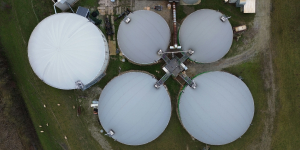The Role of the Standards in the Voluntary Carbon Market
To issue carbon credits in the Voluntary Carbon Market (VCM), a project must undergo certification by an internationally or nationally recognized standard. These standards were established to ensure compliance and integrity throughout the lifecycle of carbon projects, providing methodologies that define how carbon credits are generated and recorded in designated standards registries.
The VCM operates with numerous standards, and the sheer variety can pose challenges for market participants, who may find the multitude of standards confusing, especially given that not all standards uphold the same level of quality or rigor. In a time of growing scrutiny and controversy surrounding the VCM, ensuring the integrity of these standards is critical, as the credibility of the entire voluntary carbon sector largely depends on their robustness.
At ClimateSeed, our Projects Team is dedicated to ensuring that the carbon credits purchased by our clients result in real, verifiable impact, safeguarding the integrity of their climate actions. We partner with standards that uphold the highest levels of rigor, certifying projects that demonstrate the following attributes:
- Measurable and Permanent: Robust Monitoring, Reporting, and Verification (MRV) ensures real and lasting emissions reductions.
- Additional: Emissions reductions would not have occurred without the specific project activities.
- Independent: Project activities and impact data are verified by independent third-party auditors, ensuring unbiased assessments.
- Unique: Carbon credits must be unique, meaning they are not double-counted or claimed by another party. Registries are essential to prevent double-counting, which occurs when multiple organizations monetize or claim the same credit.
- Transparent: All certified impacts are tracked transparently through a public registry.
- Leakage-proof: Safeguards against the displacement of emissions outside the project area.
- Co-beneficial: Many standards require or incentivize projects to deliver social, environmental, and biodiversity benefits beyond carbon mitigation.
To learn more about carbon credits selection, read our dedicated article.
Here’s an overview of the standards within our projects portfolio:
Gold Standard
The Gold Standard or Gold Standard for the Global Goals, was established by the WWF and other NGOs in 2003, first within the Clean Development Mechanism (CDM) framework before expanding into the VCM. It emphasized both environmental and social integrity, requiring projects to meet the UN Sustainable Development Goals (SDGs) alongside emission reductions. Under this standard, the most common projects are renewable energy and cookstove projects, with a strong focus on delivering social co-benefits to local communities.
To learn more about SDG, read our dedicated article.
The methodologies most commonly used for the Gold Standard are the following :
1. Technologies and Practices to Displace Decentralized Thermal Energy Consumption - TPDDTEC (Cookstoves)
Widely used and recognized for projects involving efficient cookstoves, improving household energy access while reducing emissions.
2. Gold Standard Renewable Energy Activity Requirements
Popular for renewable energy projects such as wind, solar, and hydropower, with a focus on delivering broader sustainability impacts.
3. Afforestation/Reforestation and Forest Management
Eligible for projects aiming to sequester carbon through reforestation, afforestation, and sustainable forest management, aligning with both climate and biodiversity goals.
2. Verified Carbon Standard (VCS) by Verra
VCS, administered by Verra since 2008, is one of the most widely adopted standards globally, accounting for nearly 80% of certified projects in the VCM. Verra is a 501(c)(3) non-profit organization founded by environmental and business leaders who saw the need for greater quality assurance in the VCM. VCS covers a broad range of project types, including agriculture, forestry, energy, and waste management, and certifies both emission reductions and removals. Common project categories under VCS include AFOLU (Agriculture, Forestry and Other Land Use) such as REDD+ (Reducing Emissions from Deforestation and Forest Degradation), ARR (Afforestation, Reforestation, Revegetation), and IFM (Improved Forest Management).
The methodologies most commonly used for Verra's VCS are as follows :
VM0007: REDD+ Methodology Framework
One of the most widely adopted methodologies for forest-based carbon projects, focusing on avoiding deforestation and forest degradation.
VM0003: Methodology for Afforestation, Reforestation, and Revegetation (ARR) of Degraded Lands
Used for restoring degraded ecosystems through reforestation and afforestation, contributing to significant carbon sequestration.
VM0042: Methodology for Sustainable Agricultural Land Management (SALM)
Leading methodology for agriculture-related projects, enhancing soil carbon sequestration through sustainable practices.
Complementary standards managed by Verra :
Climate, Community & Biodiversity Standards (CCBS) by Verra
Managed by Verra since 2005, CCCBS focuses on land-use projects, particularly those that combine climate action with community and biodiversity benefits. Unlike standalone carbon standards, CCBS is used as a complementary certification to carbon-focused standards like the VCS, adding another layer of rigor by ensuring social and environmental benefits beyond emission reductions. CCBS does not certify carbon credits directly but instead verifies that projects meet high standards for benefiting local communities and protecting biodiversity.
The Sustainable Development Verified Impact Standard (SD VISta)
Also managed by Verra, SD VISta was the first standard focused on verifying project activities for their contributions to the UN Sustainable Development Goals (SDGs). Similar to the Gold Standard, it focuses on social, environmental, and economic co-benefits, with third-party verification ensuring the credibility of SDG contributions. Such as CCCBS, SD VISta is used as a complementary certification label. This dual focus makes projects more appealing to buyers.
While many projects certified under SD VISta and CCBS also use the VCS to generate carbon credits, both standards can be applied to projects independently of VCS.
3. Plan Vivo
Established in 1994, Plan Vivo is one of the oldest standards and focuses on community-based forestry and land-use projects managed by smallholders and local communities. The standard has a strong reputation for promoting community participation, local capacity building, and benefit-sharing, with 60% of income from the sale of Plan Vivo Certificates (PVCs) directly benefiting local communities). Projects are mostly community-owned and managed, with long-term commitments to land stewardship and social equity.
A major feature of Plan Vivo is its support for ex-ante crediting, which allows projects to issue carbon credits based on future carbon sequestration. This feature is essential for projects with long-term commitments to forest restoration or land-use change, providing early-stage funding for project development.
4. American Carbon Registry (ACR)
Founded in 1996 by Environmental Resources Trust (ERT) as the first private voluntary offset program in the world, ACR is one of the oldest carbon registries in North America, certifying projects in a variety of sectors including agriculture, forestry, methane capture, and also blue carbon. It is mainly focused on innovative carbon sequestration methodologies.
The methodologies most commonly used for ACR are the following :
- Improved Forest Management (IFM) on Non-Federal U.S. Forestlands (v2.1) Focuses on enhancing carbon sequestration by implementing sustainable forest management practices.
- Afforestation and Reforestation of Degraded Lands (v1.2) - Addresses carbon sequestration by replanting trees on degraded or deforested lands.
- Avoided Conversion of Grasslands and Shrublands to Crop Production (v2.0) Prevents the conversion of grasslands and shrublands, thus avoiding emissions related to land-use change.
To learn more about blue carbon, read our dedicated article.
5. Climate Action Reserve (CAR)
The Climate Action Reserve (CAR) was initially established in 2001 by the State of California as the California Climate Action Registry (CCAR), recognizing early efforts in emissions calculations and reporting. The California Registry helped over 400 leading California-based corporations, government agencies, and municipalities to voluntarily calculate and publicly report their GHG emissions. Its established expertise in emissions accounting translated into expertise in emissions reduction accounting for the North American carbon markets. After the Global Warming Solutions Act was passed in 2006, CAR evolved into a prominent carbon credit program, developing and updating voluntary carbon protocols.CAR is widely recognized for its forest protocols, which are designed to be context-specific, including the well-established U.S. Forest Protocol, and Mexico Forest Protocol, while actively developing new protocols for other Latin American countries. These protocols enforce robust social and environmental safeguards that project developers must comply with, to maximize co-benefits and the provision of ecosystem services for land-owners and local communities.
It focuses on high-quality offset projects based on methodologies ensuring a static baseline and reducing the risk of over-crediting. Projects certified by the CAR support environmental and community co-benefits, and often reduce local air pollution, restore habitat and ecosystems, and spur growth in new green technologies.
The methodologies most commonly used for CAR are the following :
- U.S. Forest Projects Protocol (Version 5.1) - Focuses on quantifying carbon sequestration through activities like reforestation, improved forest management (IFM), and avoided conversion of forestlands.
- U.S. Grassland Protocol (Version 2.1) - Aims to prevent the conversion of grasslands to crop production, mainly in the grasslands.
- Mexico Forest Protocol (Version 3.0) - Focuses on forest carbon sequestration through improved forest management, reforestation, and avoiding deforestation in Mexico.
To learn more about CAR’s Mexico, read our dedicated article.
6. Puro.earth
Established in 2019, Puro.earth is a newer standard, focusing on carbon removal projects with a strong emphasis on long-term sequestration through technology-based projects. It includes projects that remove and store carbon permanently or for long durations, like biochar, direct air capture (DAC), and carbon storage in building materials.
The methodologies most commonly used for Puro.earth are the following :
- Biochar Methodology - Focuses on producing biochar from biomass or biowaste through pyrolysis, which locks carbon into a stable form that can endure for hundreds to thousands of years. It's commonly applied in soil enhancement or water treatment.
- Carbonated Building Materials Methodology - Captures CO₂ through industrial byproducts like steel slag and mine tailings, transforming them into solid carbonates that trap carbon for over 1,000 years.
- Enhanced Rock Weathering Methodology - Accelerates the natural weathering process of silicate rocks, which react with carbon dioxide and water, locking carbon into a durable form over 1,000 years.
7. Label bas-carbone (LBC)
The Label bas-carbone (LBC) is a French national carbon certification standard launched in 2019 by the Ministry for Ecological Transition. It encourages and certifies local carbon reduction projects that promote sustainable practices, particularly in agriculture, forestry, and land-use sectors. The LBC, along with other national carbon certification schemes, typically reflects a higher quality and localized impact, which can be seen in the valuation of credits generated under these standards compared to international averages. This makes the LBC a significant tool for supporting France’s climate goals through domestic, high-integrity carbon projects.
The methodologies most commonly used for LBC are the following :
- Méthodologie Grande Culture - Focuses on reducing carbon emissions in large-scale crop production by optimizing agricultural practices such as reduced tillage, cover cropping, and optimized fertilizer use.
- Méthodologie Haies (Hedges) - Aimed at carbon sequestration through planting and maintaining hedgerows in agricultural landscapes, promoting biodiversity and enhancing soil carbon storage.
- Méthodologie Prairie Permanente (Permanent Grasslands) - Focuses on preserving and improving carbon sequestration in permanent grasslands through sustainable grazing and land management practices.
To learn more about Label bas carbone, read our dedicated article.
Several other examples of high-quality standards could be presented in addition to the ones previously cited. In particular, the standards endorsed by the International Carbon Reduction & Offset Alliance (ICROA).
8. ICROA
To assess the robustness of standards, the International Emissions Trading Association (IETA) launched an initiative: the International Carbon Reduction & Offset Alliance (ICROA), which accredits best practices in the Voluntary Carbon Market (VCM) and, consequently, the standards. As of today, the ICROA-endorsed standards are the following:

Sources :
- Verra (VCS, SD VISta, CCBS) : https://verra.org
- Gold Standard : https://www.goldstandard.org
- American Carbon Registry (ACR) : https://americancarbonregistry.org
- Plan Vivo : https://www.planvivo.org
- Climate Action Reserve (CAR) : https://www.climateactionreserve.org
- ISO 14064-2 : https://www.iso.org/standard/66454.html
- Label Bas Carbone : https://www.ecologie.gouv.fr/label-bas-carbone
- International Carbon Reduction & Offset Alliance (ICROA) : https://www.icroa.org
- State of the Voluntary Carbon Market 2024, Ecosystem Marketplace
Share this
You May Also Like
These Related Stories

Biogas & Household Communities in the VCM: Reducing Emissions & Empowering Communities

Why Avoidance Credits are not Inherently Inferior to Removal Ones

